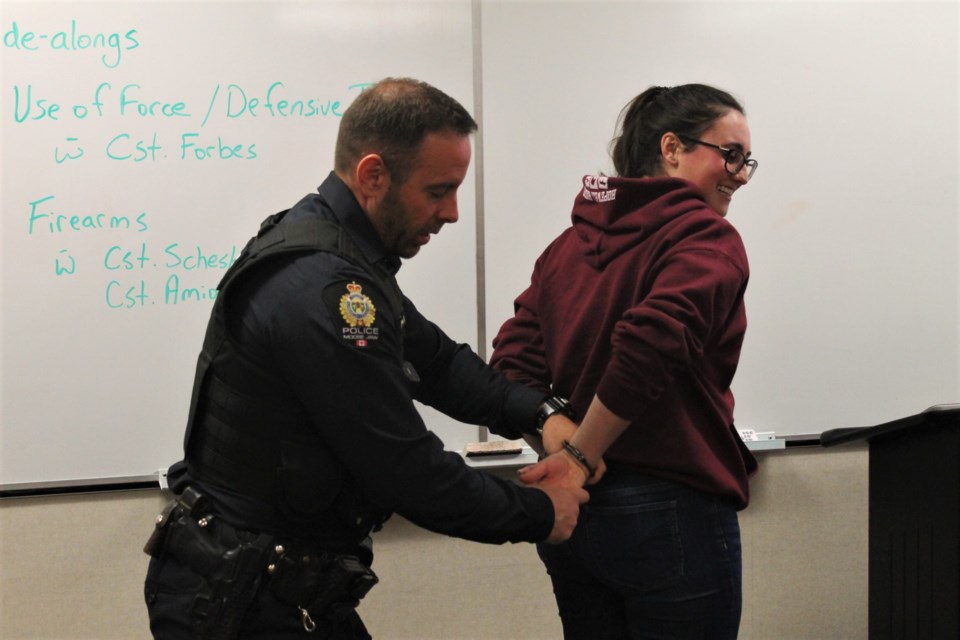The parameters that define the acceptable conditions for use of force tactics have been a hot topic in the media, so Const. Ryan Forbes shared his expertise as a defensive tactics instructor and a member of the Moose Jaw Police Force.
Forbes — who acts as an instructor in defensive tactics, baton use, and use of force strategy at both the MJPS and the Regina Police Academy — began with a rundown of the legislation that addresses defensive actions from police members.
The Criminal Code of Canada essentially states that officers are granted the ability to address a situation with the force they deem necessary, but they must be prepared to explain exactly why they chose a certain response.
“Everything has to be a balance,” said Forbes. “Section 25 says you have the authority to do what you need to stop the bad guy and save the day. However, turn the page and (Section 26 says) you are also responsible criminally for excessive force.”
All officers are equipped with defensive physical training, as well as intermediate tools — a collapsible baton, pepper spray, and a taser gun with two cartridges — and a firearm, with two extra magazines.
Every officer in the MJPS follows a set of guidelines during any situation on the job, which Forbes explained. The Use of Force Model is the mandate that determines how officers prioritize their actions on a call, and officers are constantly re-evaluating the situation based on this circular model.
The five steps of the Use of Force model determine what level of force an officer might use in response to the level of aggression exhibited by the situation.
For example, an individual speaking with an officer and answering questions is met with a low exhibition of force, likely just officer presence and communication. Conversely, an individual who continually walks away may be met with physical restraint, and someone who shows assaultive movements towards an officer could possibly be met with the most appropriate intermediate tool.
Individuals threatening bodily harm, either their own or another’s, with a weapon could be met with lethal use of force actions.
These tactical considerations are constantly being processed, with every shift in a situation, to find the best method of controlling what is happening.
Officers have to consider the lasting effects of whatever type of force they use, and what would be most effective based on a number of factors. Often, those decisions have to happen in an extremely quick process.
Time and distance — between a subject and an officer — are extremely important factors and are some of the first things that MJPS members consider as they assess a situation.
“When you're actually out on the street and the pressure's on, you have seconds,” said Forbes. “The hard part of the job is that you have to make a very hard decision, very quickly, with very limited information.”
Every officer creates a line in the sand, which is a set distance that, when crossed, instigates a decided use of force action — whether it is an intermediate or a lethal use of force.
This, said Forbes, is where things become complicated — every officer’s line in the sand is different because every officer’s perception in a situation differs.
For the most part, MJPS members only use their use of force tools as last-choice options. As a part of training, officers with the MJPS are actually pepper-sprayed, to properly understand the lasting effects.
It is also MJPS policy to issue a public statement every time a member uses any of their intermediate tools or firearm in an altercation — which hasn’t happened in a long time.
“If it's practicable, we need to use our officer presence and communication,” said Const. Kyle Cunningham. “If we have time to say, 'police, stop,' then we say, 'police stop.'”
Every MJPS officer is trained to continually assess the situation using the Use of Force model, and to make all efforts to mitigate any potential damage to both officers and civilians in any situation.
“Every officer is different and that's what makes this job so dynamic,” said Forbes. “We have all the big problems that bigger cities have, you just don't hear about them as often because we pride ourselves on doing a better job, of managing it while staying out of the media.”
Details for this article were collected as part of the Moose Jaw Express’s attendance at the Community Police Academy.




